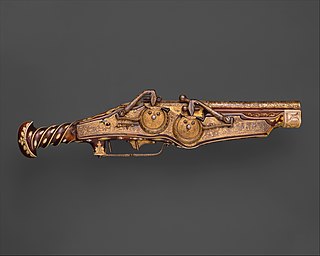 W
WThe Metropolitan Museum of Art holds a 16th-century combination weapon in its armaments collection. The weapon is an 89 3/4 inch boar spear with two wheellock pistol barrels fused to both flat sides of the spear's head; the intent of this design was to provide the wielder with the extra stopping power of two .41 caliber musket balls that could be fired at targets out of the reach of the spear. Some sources posit that such weapons were instead experimental pieces or curiosities. The 9 lb, German-made weapon was donated to the Met's collection by the Roger's fund in 1904.
 W
WA double-barreled wheellock pistol was crafted by German gunsmith Peter Peck for Charles V in 1540. It is one of the oldest surviving European pistols. It is in the collection of the Metropolitan Museum of Art.
 W
WThe Armor of Emperor Ferdinand I is a suit of plate armor created by the Nuremberg armorer Kunz Lochner in 1549 for the future Ferdinand I, Holy Roman Emperor. One of several suits of armor made for the Emperor Ferdinand during the wars of Reformation and conflict with the Ottomans, the etched but functional armor is thought by scholars to symbolize and document the role of the Habsburg Catholic monarchs as warriors on Europe's literal and ideological battlefields.
 W
WThe Monteleone chariot is an Etruscan chariot dated to c. 530 BC, considered one of the world's great archaeological finds. It was originally uncovered at Monteleone di Spoleto and is currently a star attraction in the collection of the Metropolitan Museum of Art in New York City.
 W
WThe O-yoroi Armor of Ashikaga Takauji [白絲威褄取鎧(しろいとおどしつまどりよろい)]Shiro-ito Odoshi Tsumadori O-yoroi) is a piece of Japanese armour made for the shogun of the Ashikaga shogunate, Ashikaga Takauji. This piece of armor belongs in the Arms and Armor Department of the Metropolitan Museum of Art.
 W
WThe Metropolitan Museum of Art holds a pair of late 18th century flintlock pistols belonging to Catherine the Great in its collection. Made from steel, brass and adorned with ivory and gold, the pistols are currently on display in Gallery 375.
 W
WThe Parade Armour of Henry II of France, now in Metropolitan Museum of Art, New York, is believed to date from c 1553–55 and its decoration is attributed to the French goldsmith and engraver Étienne Delaune. Designed for use in pageantry, the armour was fashioned of gold, silver and steel and with leather and red velvet trimmings. It was created for Henry II of France as ceremonial wear; the figures embossed on the breastplate and back are intended to reflect his military achievements.